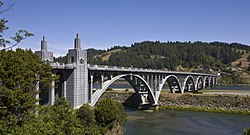Isaac Lee Patterson Bridge | |
|---|---|
 | |
| Coordinates | 42°25′38″N 124°24′48″W / 42.4272°N 124.4133°W |
| Carries | 2 lanes of |
| Crosses | Rogue River |
| Locale | Gold Beach, Oregon to Wedderburn, Oregon |
| Maintained by | State of Oregon |
| ID number | 01172 009 32764 |
| Characteristics | |
| Design | Concrete arch-deck |
| Total length | 591 metres (1,939 ft) |
| Width | 8.2 metres (27 ft) |
| Longest span | 70 metres (230 ft), 7 spans |
| History | |
| Opened | May 28, 1932 |
| Statistics | |
| Daily traffic | 6200 |
| Location | |
 | |
Rogue River Bridge No. 01172 | |
| Location | OR Coast 9, US 101, MP 327.70, Gold Beach, Oregon |
|---|---|
| Area | 2.6 acres (1.1 ha) |
| Built | 1932 |
| Architect | Conde B. McCullough; Mercer-Fraser Co. |
| MPS | McCullough, C. B., Major Oregon Coast Highway Bridges MPS |
| NRHP reference No. | 05000814[1] |
| Added to NRHP | August 5, 2005 |
The Isaac Lee Patterson Bridge, also known as the Rogue River Bridge and the Isaac Lee Patterson Memorial Bridge, is a concrete arch bridge that spans the Rogue River in Curry County, Oregon. The bridge was constructed by the Mercer Fraser Company of Eureka, California. The bridge carries U.S. Route 101 across the river, near the point where the river empties into the Pacific Ocean, and connects the towns of Gold Beach and Wedderburn. A bridge with strong Art Deco influences, the Isaac Lee Patterson Bridge is a prominent example of the designs of the Oregon bridge designer and highway engineer Conde McCullough. It was designated a National Historic Civil Engineering Landmark by the American Society of Civil Engineers in 1982. It is part of a series of notable bridges designed by McCullough for the Oregon Coast Highway in the 1930s. It was placed on the National Register of Historic Places in 2005.

